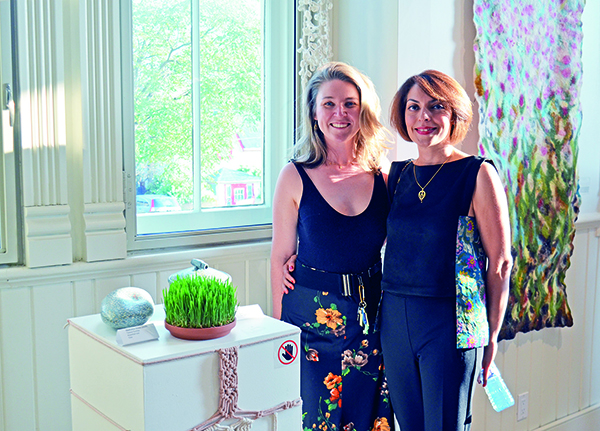Arts and Culture » General News » News
“Change happens when we all come together”
August 21, 2025 · 0 Comments

A walk in the woods can change perspectives.
The sight of a tree, for instance, might spark images of a solitary being standing tall and proud. Scratch the surface, however, and you’ll see a series of interconnecting roots and fibres that cast doubt on the idea that anyone or anything truly stands alone.
And, for Parisa Sabet and Laura Friedmann, neither does a community.
This is an idea explored by the two artists, and scores of their collaborators, in Sabzeh, a new exhibition which opened last week at the Aurora Cultural Centre.
The show explores the interconnectedness in just about every facet of our world through the lens of stitches in fabric, such as the elaborate work that comes together to form an intricate Persian rug, as well as the Sabzeh themselves – sprouts that stand tall on a bed of interconnected and inextricable roots.
Sabzeh blends together traditional and contemporary media, such as woven fabrics, soundscapes, and video projections to drive home this message, transforming the Centre’s two Homeroom Galleries into an immersive experience.
“The project meditates on themes of rebirth and renewal, connection to the past, and the strength found in community,” says the Centre. “It invites the viewers to look inward and reflect on the threads of interconnection that binds us to one another – and to all living things.”
Sabzeh is an exhibition that is more than three years in the making.
The brainchild of Sabet, who has previously served on the Aurora Cultural Centre’s Board of Directors, it was initially envisioned as a small, quick, experimental show, inspired by the short story “Sabzeh” by Omid Fallahazad. But, as Friedmann and a host of collaborators came on board, it evolved into much more than that.
“There are two elements in the story – one is the ritual of growing sprouts, and the other one is the art of making handmade carpets,” Sabet told The Auroran as she surveyed the installed works ahead of last Thursday’s Opening Night reception, which packed both Homeroom galleries with collaborators, supporters from both Canada and the United States, and dignitaries including Mayor Tom Mrakas.
“The whole idea is that the seeds of the sprout grow together, and when they grow together, if you look at the bottom, the roots, they all come together, and to create that beauty is the idea of all these needs to grow together. Some of them might grow tall, some of them might grow short, but the whole thing is that this beauty only comes together when they all come together. It’s the same thing with the knots in the carpet. The whole idea is that if you’re looking for a change, we all need to come together.
“Change happens when we all come together just like that. If you want change, to grow as a community, it’s just [a matter of] coming together and accepting each other. Each of us are at some stage of our growth, but the whole thing is we accept each other the way that we are.”
Sabzeh, she added, is a symbol of new life and hope during the season of Nowruz, the Persian New Year, and, like carpets, the plants have been “grown from the hands and the hearts of many people from all walks of life, who came together across borders with care and intention.”
“This immersive installation blends sound, movement, fiber, and image, inviting us to slow down, breathe, and reflect on the strength, longing, and the courage we find in community,” she continued. “[The short story honoured] the memory of ten courageous women who remained unwavering in the face of adversity. Two elements guided us: the ritual of growing sprouts and the art of weaving a handmade carpet. Both remind us that with steady hands and open hearts, we can nurture seeds and threads of resilience, connection, and a future shaped by care. I’m deeply grateful to the many artists who brought Sabzeh to life, and to the artists’ contributors who shared their beautiful work.”
Friedmann added when Sabet reached out to her with the initial idea, she was first asked to make a single tapestry for the exhibition, but that “one tapestry became enormous and an immersive experience.”
“One of the beautiful things of the story [deals with] 10 blind women who are lost and there is a mother who is dealing with grief, so she starts to weave a carpet in order to deal with that grief. This is the way she survives day-by-day and I really related to this,” she shared. “I also have channelled my grief though my loom and I have found a lot of healing in making many, many knots – and I encourage all of you to try to do this with your hands, too.
“We are really one human family and we cannot survive without each other. I know that in this project I brought my late father a lot to mind, and he helped me in very strange ways from the spiritual world. I encourage you to think about those people who have supported you, whether they’re in this world or have already left, and really to take this idea that we’re all interconnected and we’re all one with you every day, because the world certainly needs it.”
Sabzeh runs at the Aurora Cultural Centre through October 19.
An artist-poet gathering will take place within the exhibition on Wednesday, August 27, from 7 – 9 p.m., where participants will be invited to create spontaneous written or visual responses to the artworks on display.
The show will close with a special panel discussion on Sunday, October 19, featuring several of the collaborators who contributed to the project, including Sabet, and Friedmann, as well as Bahia Marks, Rah Eleh, and Olya Glotka.
For more information, visit auroraculturalcentre.ca.
By Brock Weir
Editor
Local Journalism Initiative Reporter












